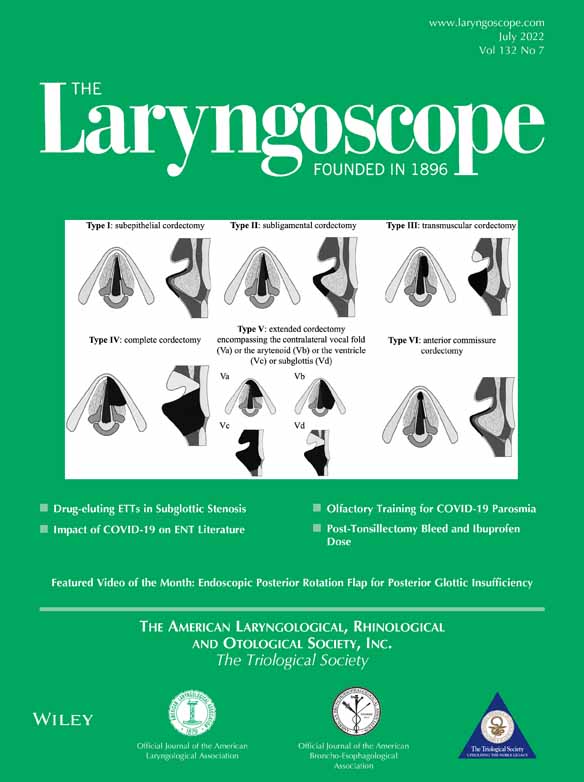In Response to Clinical Features of Parosmia Associated with COVID-19 Infection
Corresponding Author
Luigi Angelo Vaira MD
Maxillofacial Surgery Operative Unit, Department of Medical, Surgical and Experimental Sciences, University of Sassari, Sassari, Italy
Biomedical Science Department, PhD School of Biomedical Science, University of Sassari, Sassari, Italy
Send correspondence to: Luigi Angelo Vaira, MD, Viale San Pietro 43/B, Sassari, Italy.
E-mail: [email protected]
Search for more papers by this authorGiacomo De Riu MD, FEBOMFS
Maxillofacial Surgery Operative Unit, Department of Medical, Surgical and Experimental Sciences, University of Sassari, Sassari, Italy
Search for more papers by this authorGiovanni Salzano MD
ENT and Maxillofacial Surgery Unit, Istituto Tumori G. Pascale of Naples, Naples, Italy
Maxillofacial Surgery Unit, University Hospital of Naples “Federico II”, Naples, Italy
Search for more papers by this authorFabio Maglitto MD
Maxillofacial Surgery Unit, University Hospital of Naples “Federico II”, Naples, Italy
Search for more papers by this authorPaolo Boscolo-Rizzo MD
Department of Medical, Surgical and Health Sciences, Section of Otolaryngology, University of Trieste, Trieste, Italy
Search for more papers by this authorJerome R. Lechien MD, PhD
Department of Anatomy and Experimental Oncology, Mons School of Medicine, UMONS Research Institute for Health Sciences and Technology, University of Mons (UMons), Mons, Belgium
Department of Otolaryngology-Head Neck Surgery, Elsan Hospital, Paris, France
Search for more papers by this authorCorresponding Author
Luigi Angelo Vaira MD
Maxillofacial Surgery Operative Unit, Department of Medical, Surgical and Experimental Sciences, University of Sassari, Sassari, Italy
Biomedical Science Department, PhD School of Biomedical Science, University of Sassari, Sassari, Italy
Send correspondence to: Luigi Angelo Vaira, MD, Viale San Pietro 43/B, Sassari, Italy.
E-mail: [email protected]
Search for more papers by this authorGiacomo De Riu MD, FEBOMFS
Maxillofacial Surgery Operative Unit, Department of Medical, Surgical and Experimental Sciences, University of Sassari, Sassari, Italy
Search for more papers by this authorGiovanni Salzano MD
ENT and Maxillofacial Surgery Unit, Istituto Tumori G. Pascale of Naples, Naples, Italy
Maxillofacial Surgery Unit, University Hospital of Naples “Federico II”, Naples, Italy
Search for more papers by this authorFabio Maglitto MD
Maxillofacial Surgery Unit, University Hospital of Naples “Federico II”, Naples, Italy
Search for more papers by this authorPaolo Boscolo-Rizzo MD
Department of Medical, Surgical and Health Sciences, Section of Otolaryngology, University of Trieste, Trieste, Italy
Search for more papers by this authorJerome R. Lechien MD, PhD
Department of Anatomy and Experimental Oncology, Mons School of Medicine, UMONS Research Institute for Health Sciences and Technology, University of Mons (UMons), Mons, Belgium
Department of Otolaryngology-Head Neck Surgery, Elsan Hospital, Paris, France
Search for more papers by this authorThe authors have no funding, financial relationships, or conflicts of interest to disclose.
REFERENCES
- 1Lerner DK, Garvey KL, Arrighi-Allisan AE, et al. Clinical features of parosmia associated with COVID-19 infection. Laryngoscope. 2022; 132: 633-639.
- 2Khan M, Yoo SJ, Clijsters M, et al. Visualizing in deceased COVID-19 patients how SARS-CoV-2 attacks the respiratory and olfactory mucosae but spares the olfactory bulb. Cell. 2021; 184: 5932-5949.e15.
- 3Vaira LA, Hopkins C, Sandison A, et al. Olfactory epithelium histopathological findings in long-term coronavirus disease 2019 related anosmia. J Laryngol Otol. 2020; 134: 1123-1127.
- 4Kirschenbaum D, Imbach LL, Ulrich S, et al. Inflammatory olfactory neuropathy in two patients with COVID-19. Lancet. 2020; 396: 166.
- 5Reyna RA, Kishimoto M, Urata S, Makishima T, Paessler S, Maruyama J. Recovery of anosmia in hamsters infected with SARS-CoV-2 is correlated with repair of the olfactory epithelium. Sci Rep. 2022; 12:628.
- 6Yu P, Deng W, Bao L, et al. Comparative pathology of the nasal epithelium in K18-hACE2 Tg mice, hACE2 Tg mice, and hamsters infected with SARS-CoV-2. Vet Pathol. 2022. https://doi.org/10.1177/03009858211071016.
- 7Graziadei PPC, Monti Graziadei GA. Neurogenesis and neuron regeneration in the olfactory system of mammals. I. Morphological aspects of differentiation and structural organization of the olfactory sensory neurons. J Neurocytol. 1979; 8: 1-18.
- 8Saniasiaya J, Narayanan P. Parosmia post COVID-19: an unpleasant manifestation of long COVID syndrome. Postgrad Med J. 2022; 98:e96.
- 9Parker JK, Kelly CE, Gane SB. Molecular mechanism of parosmia. medRxiv. 2021. doi:https://doi.org/10.1101/2021.02.21251085.
- 10Boscolo-Rizzo P, Hummel T, Hopkins C, et al. High prevalence of long-term olfactory, gustatory, and chemesthesis dysfunction in post-COVID-19 patients: a matched case-control study with one-year follow-up using a comprehensive psychophysical evaluation. Rhinology. 2021; 59: 517-527.
- 11Vaira LA, Salzano G, Le Bon S, et al. Prevalence of persistent olfactory disorders in patients with COVID-19: a psychophysical case-control study with 1-year follow-up. Otolaryngol Head Neck Surg. 2021;1945998211061511. https://doi.org/10.1177/01945998211061511.
- 12Liu DT, Welge-Lussen A, Besser G, Mueller CA, Renner B. Assessment of odor hedonic perception: the Sniffin' sticks parosmia test (SSParoT). Sci Rep. 2020; 22:18019.
- 13Vaira LA, Gessa C, Deiana G, et al. The effects of persistent olfactory and gustatory dysfunctions on quality of life in long-COVID-19 patients. Life. 2022; 12:141.




